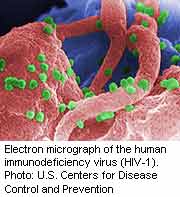
WEDNESDAY, April 4 (HealthDay News) — A new study offers insight into why an HIV vaccine failed to protect most people who received it, but it also points to promising new targets for future vaccine efforts.
Scientists believe an HIV vaccine, designed to prevent infection with the virus that causes AIDS, is still several years away. Tests of experimental vaccines have largely been failures so far.
Nevertheless, the prospect of a vaccine remains tantalizing because it could make a major dent in the spread of HIV and AIDS around the world.
The new research “gives us a handle on how the immune system deals with the virus and is affected by a vaccine,” said study lead author Dr. Barton Haynes, director at the Duke Human Vaccine Institute at Duke University in Durham, N.C. “It gives us clues and a firm direction to look into.”
The study is based on work by more than 100 scientists from 25 institutions, and appears in the April 5 issue of the New England Journal of Medicine.
Haynes and his colleagues examined the results of a 2009 study of an HIV vaccine in Thailand. In a trial involving more than 16,000 people, the vaccine appeared to cut the risk of infection by only 31 percent. That was still considered a major advance over previous vaccines that didn’t work at all, Haynes noted.
The vaccine, called RV144, wasn’t ready for prime time because it didn’t protect enough people, Haynes said. “You want to get it above 50 percent,” he said, and some scientists believe the rate should be even higher than that.
Despite the vaccine’s failure, the authors of the new study were able to use the data to learn more about how the immune system deals with HIV and how the vaccine changes the “big picture” of the body’s response to the virus.
The new research is an “exhaustive molecular analysis,” said Dr. Lindsey Baden, an associate professor of medicine in the infectious disease division at Brigham and Women’s Hospital in Boston who co-wrote a commentary accompanying the study.
Haynes said one surprising finding is about an antibody — a soldier of the immune system — that helps protect against influenza infection. Ironically, the antibody appears to mitigate the effect of antibodies that might otherwise help protect against HIV, he said.
Another finding was that higher levels of antibodies that home in on a particular region of HIV’s outer shell, called V1V2, were associated with lower rates of infection with the virus.
This and other information in the study may help researchers come up with theories about where to go next with vaccine development, Baden said. Among other things, it can reveal parts of the immune system that can be most useful in battling the transmission of HIV.
Vaccines are available to fight other kinds of viruses, such as measles and influenza. HIV is unique, however, because it inserts its genetic material into the body’s cells.
“When a person gets infected with HIV, that genetic material goes underground,” Haynes said. “It’s invisible to the body’s immune system.”
Another challenge is that the virus mutates, becoming a moving target.
“It changes so rapidly in the person who gets infected that even when the immune system does try to control it, in most people the immune system is always playing catch up,” Haynes said.
More information
There’s more on HIV/AIDS at the U.S. National Library of Medicine.

